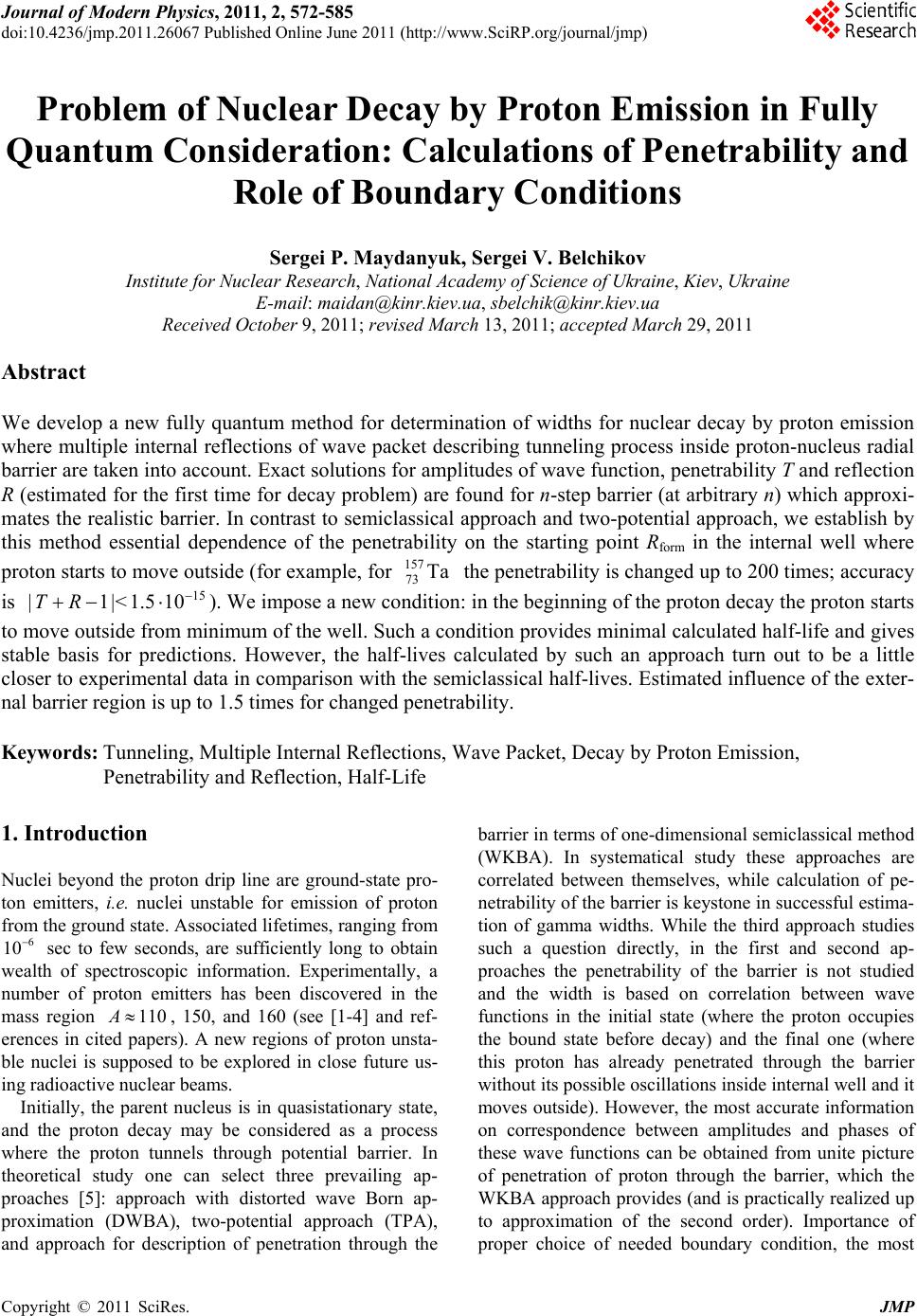 Journal of Modern Physics, 2011, 2, 572-585 doi:10.4236/jmp.2011.26067 Published Online June 2011 (http://www.SciRP.org/journal/jmp) Copyright © 2011 SciRes. JMP Problem of Nuclear Decay by Proton Emission in Fully Quantum Consideration: Calculations of Penetrability and Role of Boundary Conditions Sergei P. Maydanyuk, Sergei V. Belchikov Institute for Nuclear Research, National Academy of Science of Ukraine, Kiev, Ukraine E-mail: maidan@kinr.kiev.ua, sbelchik@kinr.kiev.ua Received October 9, 2011; revised March 13, 2011; accepted March 29, 2011 Abstract We develop a new fully quantum method for determination of widths for nuclear decay by proton emission where multiple internal reflections of wave packet describing tunneling process inside proton-nucleus radial barrier are taken into account. Exact solutions for amplitudes of wave function, penetrability T and reflection R (estimated for the first time for decay problem) are found for n-step barrier (at arbitrary n) which approxi- mates the realistic barrier. In contrast to semiclassical approach and two-potential approach, we establish by this method essential dependence of the penetrability on the starting point Rform in the internal well where proton starts to move outside (for example, for the penetrability is changed up to 200 times; accuracy is ). We impose a new condition: in the beginning of the proton decay the proton starts to move outside from minimum of the well. Such a condition provides minimal calculated half-life and gives stable basis for predictions. However, the half-lives calculated by such an approach turn out to be a little closer to experimental data in comparison with the semiclassical half-lives. Estimated influence of the exter- nal barrier region is up to 1.5 times for changed penetrability. 157 73 Ta 15 |1|<1.510TR Keywords: Tunneling, Multiple Internal Reflections, Wave Packet, Decay by Proton Emission, Penetrability and Reflection, Half-Life 1. Introduction Nuclei beyond the proton drip line are ground-state pro- ton emitters, i.e. nuclei unstable for emission of proton from the ground state. Associated lifetimes, ranging from sec to few seconds, are sufficiently long to obtain wealth of spectroscopic information. Experimentally, a number of proton emitters has been discovered in the mass region , 150, and 160 (see [1-4] and ref- erences in cited papers). A new regions of proton unsta- ble nuclei is supposed to be explored in close future us- ing radioactive nuclear beams. 6 10 110A Initially, the parent nucleus is in quasistationary state, and the proton decay may be considered as a process where the proton tunnels through potential barrier. In theoretical study one can select three prevailing ap- proaches [5]: approach with distorted wave Born ap- proximation (DWBA), two-potential approach (TPA), and approach for description of penetration through the barrier in terms of one-dimensional semiclassical method (WKBA). In systematical study these approaches are correlated between themselves, while calculation of pe- netrability of the barrier is keystone in successful estima- tion of gamma widths. While the third approach studies such a question directly, in the first and second ap- proaches the penetrability of the barrier is not studied and the width is based on correlation between wave functions in the initial state (where the proton occupies the bound state before decay) and the final one (where this proton has already penetrated through the barrier without its possible oscillations inside internal well and it moves outside). However, the most accurate information on correspondence between amplitudes and phases of these wave functions can be obtained from unite picture of penetration of proton through the barrier, which the WKBA approach provides (and is practically realized up to approximation of the second order). Importance of proper choice of needed boundary condition, the most  S. P. MAYDANYUK ET AL. 573 correctly and closely corresponded to decay, reinforces our interest in the fully quantum consideration of unite tunneling process in this task, while the detailed analysis of selection this boundary condition and its real influence on results is practically missed in TPA and DWBA ap- proaches. Affirmed errors in calculations of half-lives by modern TPA and WKBA models are about some percents. In this paper we show that if to take into account influence by the internal and external regions of the barrier neglected in TPA, DWBA and WKBA approaches, that one can obtain change of results up to 200 times (i.e. 20000 per- cents)! Note that our method has not been accepted by authors of TPA, DWBA and WKBA models. But it is easy to clarify effectiveness and proper description and estimation of the penetration through the barrier in any model if to use well known tests of quantum mechanics (like where T and R are penetrability and reflection concerning the barrier). In this paper we show that in the WKBA, TPA, DWBA models such tests are not applicable, while we give apparatus how to work with them. We analyze in details which approach has more grounds, is really fully quantum, richer and more accurate. And we give clear and simple explanation for difference between our approach and their ones consisted in essential role of the boundary condition. =1TR The main objective of this paper is to pass from semi- classical unite description of the process of penetration of proton through the barrier used in the WKBA ap- proach to its fully quantum analogue, to put a fully quantum grounds for determination of the penetrability in this problem. In order to provide such a formalism, we have improved method of multiple internal reflections (MIR, see [6-10]) generalizing it on the radial barriers of arbitrary shapes. In order to realize this difficult im- provement, we have restricted ourselves by consideration of the spherical ground-state proton emitters, while nu- clear deformations are supposed to be further included by standard way. This advance of the method never stu- died before allows to describe dynamically a process of penetration of the proton through the barrier of arbitrary shape in fully quantum consideration, to calculate pene- trability and reflection without the semiclassical restric- tions, to analyze abilities of the semiclassical and other models on such a basis. This paper is organized in the following way. In Sec- tion 2, formalism of the method of multiple internal re- flections in description of tunneling of proton through the barrier in proton decay is presented. Here, we give solutions for amplitudes, define penetrability, width and half-life. In Section 3, results of calculations are con- fronted with experimental data and are compared with semiclassical ones. Here, using the fully quantum basis of the method, we study a role of the barrier shape in calculations of widths in details. In particular, for the first time we observe essential influence of the internal well before the barrier on the penetrability that necessi- tates to introduce initial condition which should be im- posed on the proton decay in its fully quantum consid- eration. We discuss shortly possible interconnections between the proposed approach and other fully quantum methods of calculation of widths. In Section 4, we sum- marize results. Appendixes include proof of the method MIR and alternative standard approach of quantum me- chanics used as test for the method MIR and for the re- sults presented. 2. Theoretical Approach An approach for description of one-dimensional motion of a non-relativistic particle above a barrier on the basis of multiple internal reflections of stationary waves rela- tively boundaries has been studied in number of papers and is known (see [11-13] and references therein). Tun- neling of the particle under the barrier was described successfully on the basis of multiple internal reflections of the wave packets relatively boundaries (approach was called as method of multiple internal reflections or me- thod MIR, see [6-9]). In such approach it succeeded in connecting: 1) continuous transition of solutions for packets after each reflection, total packets between the above-barrier motion and the under-barrier tunneling; 2) coincidence of transmitted and reflected amplitudes of stationary wave function in each spatial region obtained by approach MIR with the corresponding amplitudes obtained by standard method of quantum mechanics; 3) all non-stationary fluxes in each step, are non-zero that confirms propagation of packets under the barrier (i.e. their “tunneling”). In frameworks of such a method, non-stationary tunneling obtained own interpretation, allowing to study this process at interesting time moment or space point. In calculation of phase times this method turns out to be enough simple and convenient [10]. It has been adapted for scattering of the particle on nucleus and -decay in the spherically symmetric approximation with the simplest radial barriers [6,7,9] and for tunneling of photons [7,10]. However, further realization of the MIR approach meets with three questions. 1) Question on effectiveness. The multiple reflections have been proved for the motion above one rectangular barrier and for tunneling under it [7,10,13]. However, after addition of the second step it becomes unclear how to separate the needed reflected waves from all their va- riety in calculation of all needed amplitudes. After ob- taining exact solutions of the stationary amplitudes for two arbitrary rectangular barriers [6,9], it becomes un- Copyright © 2011 SciRes. JMP 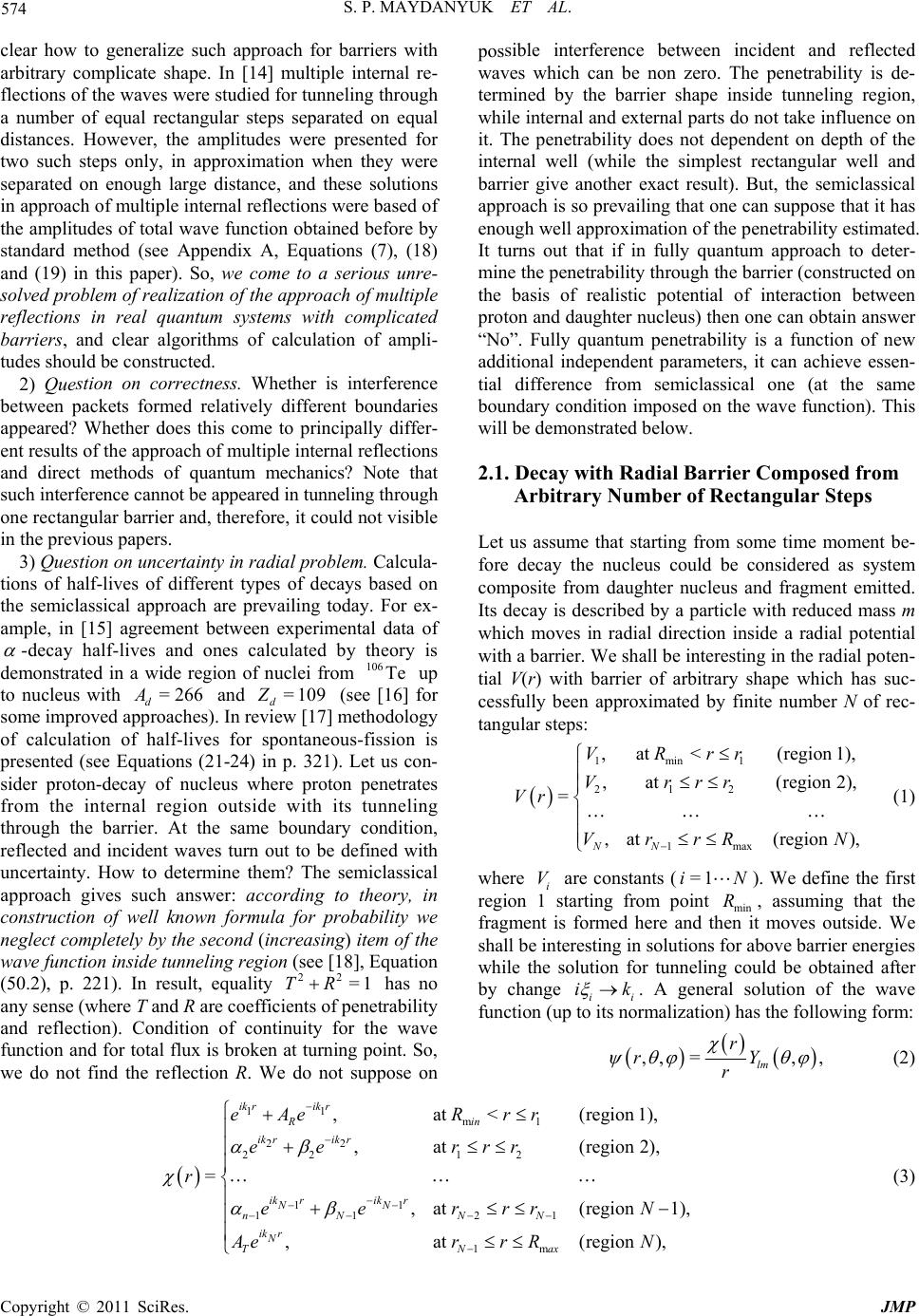 S. P. MAYDANYUK ET AL. Copyright © 2011 SciRes. JMP 574 clear how to generalize such approach for barriers with arbitrary complicate shape. In [14] multiple internal re- flections of the waves were studied for tunneling through a number of equal rectangular steps separated on equal distances. However, the amplitudes were presented for two such steps only, in approximation when they were separated on enough large distance, and these solutions in approach of multiple internal reflections were based of the amplitudes of total wave function obtained before by standard method (see Appendix A, Equations (7), (18) and (19) in this paper). So, we come to a serious unre- solved problem of realization of th e app roach of mu ltiple reflections in real quantum systems with complicated barriers, and clear algorithms of calculation of ampli- tudes should be constructed. possible interference between incident and reflected waves which can be non zero. The penetrability is de- termined by the barrier shape inside tunneling region, while internal and external parts do not take influence on it. The penetrability does not dependent on depth of the internal well (while the simplest rectangular well and barrier give another exact result). But, the semiclassical approach is so prevailing that one can suppose that it has enough well approximation of the penetrability estimated. It turns out that if in fully quantum approach to deter- mine the penetrability through the barrier (constructed on the basis of realistic potential of interaction between proton and daughter nucleus) then one can obtain answer “No”. Fully quantum penetrability is a function of new additional independent parameters, it can achieve essen- tial difference from semiclassical one (at the same boundary condition imposed on the wave function). This will be demonstrated below. 2) Question on correctness. Whether is interference between packets formed relatively different boundaries appeared? Whether does this come to principally differ- ent results of the approach of multiple internal reflections and direct methods of quantum mechanics? Note that such interference cannot be appeared in tunneling through one rectangular barrier and, therefore, it could not visible in the previous papers. 2.1. Decay with Radial Barrier Composed from Arbitrary Number of Rectangular Steps Let us assume that starting from some time moment be- fore decay the nucleus could be considered as system composite from daughter nucleus and fragment emitted. Its decay is described by a particle with reduced mass m which moves in radial direction inside a radial potential with a barrier. We shall be interesting in the radial poten- tial V(r) with barrier of arbitrary shape which has suc- cessfully been approximated by finite number N of rec- tangular steps: 3) Question on unc ertainty in rad ial problem. Calcula- tions of half-lives of different types of decays based on the semiclassical approach are prevailing today. For ex- ample, in [15] agreement between experimental data of -decay half-lives and ones calculated by theory is demonstrated in a wide region of nuclei from up to nucleus with and (see [16] for some improved approaches). In review [17] methodology of calculation of half-lives for spontaneous-fission is presented (see Equations (21-24) in p. 321). Let us con- sider proton-decay of nucleus where proton penetrates from the internal region outside with its tunneling through the barrier. At the same boundary condition, reflected and incident waves turn out to be defined with uncertainty. How to determine them? The semiclassical approach gives such answer: according to theory, in construction of well known formula for probability we neglect completely by the seco nd (increa s in g) item of the wave function inside tunneling region (see [18], Equation (50.2), p. 221). In result, equality has no any sense (where T and R are coefficients of penetrability and reflection). Condition of continuity for the wave function and for total flux is broken at turning point. So, we do not find the reflection R. We do not suppose on 106 Te =1 = 266 d A=109 d Z 22 TR 1min1 212 1max ,at <(region1), ,at (region2), = ,at (region), NN VRrr Vrrr Vr VrrR N (1) where i are constants (). We define the first region 1 starting from point min , assuming that the fragment is formed here and then it moves outside. We shall be interesting in solutions for above barrier energies while the solution for tunneling could be obtained after by change ii V=1i RN ki . A general solution of the wave function (up to its normalization) has the following form: ,,=, , lm r rY r (2) 11 m1 22 22 12 11 11 21 1m ,at <(region1), ,at (region2), = ,at (region1), ,at (region), ik rik r Rin ik rik r ik rik r NN nN NN ik r N TNax eAe Rrr ee rrr r eerrr N Aerr RN (3) 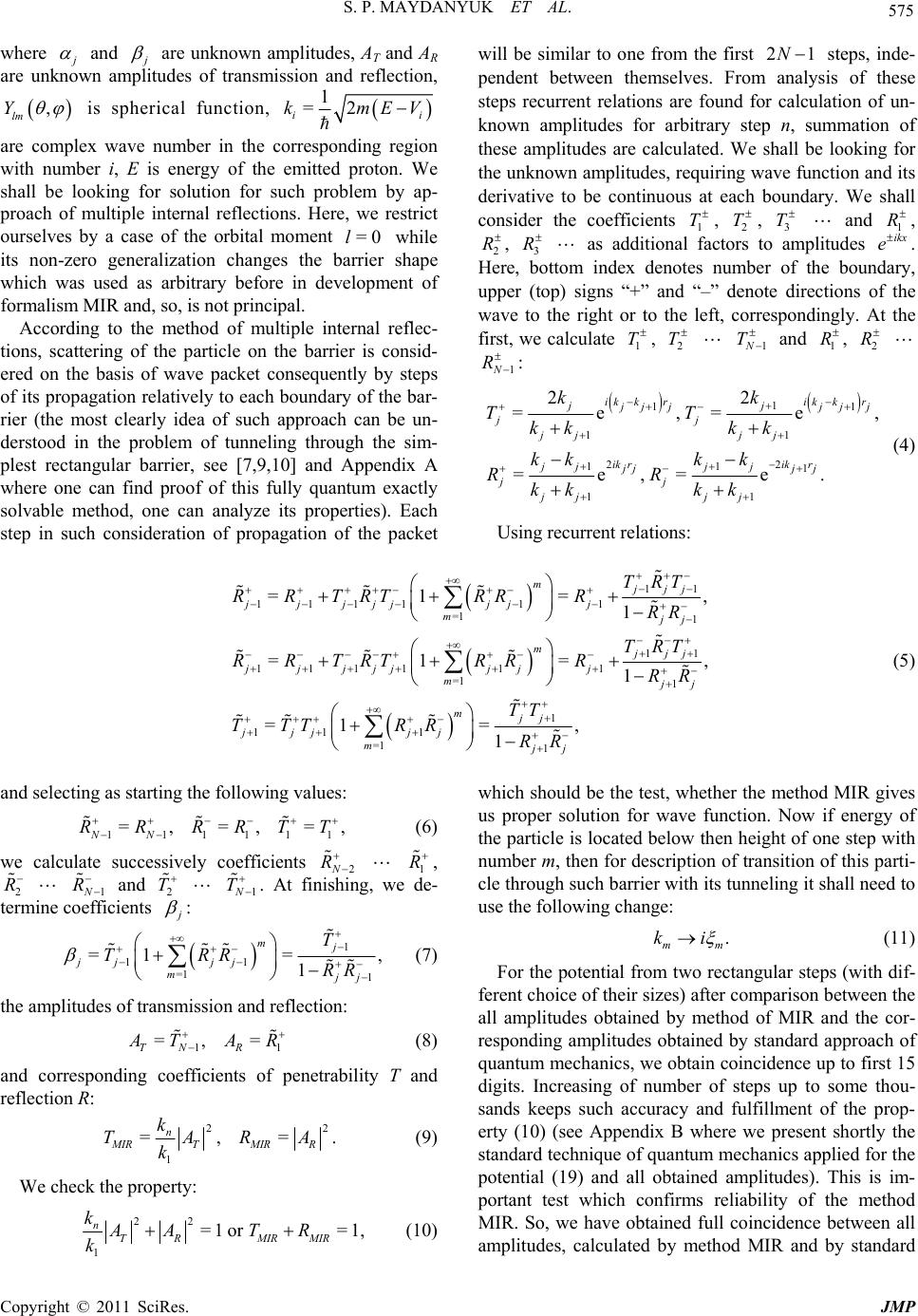 S. P. MAYDANYUK ET AL. Copyright © 2011 SciRes. JMP 575 where and are unknown amplitudes, AT and AR are unknown amplitudes of transmission and reflection, , lm Y is spherical function, 1 =2 i kmE i V 1 are complex wave number in the corresponding region with number i, E is energy of the emitted proton. We shall be looking for solution for such problem by ap- proach of multiple internal reflections. Here, we restrict ourselves by a case of the orbital moment while its non-zero generalization changes the barrier shape which was used as arbitrary before in development of formalism MIR and, so, is not principal. =0l According to the method of multiple internal reflec- tions, scattering of the particle on the barrier is consid- ered on the basis of wave packet consequently by steps of its propagation relatively to each boundary of the bar- rier (the most clearly idea of such approach can be un- derstood in the problem of tunneling through the sim- plest rectangular barrier, see [7,9,10] and Appendix A where one can find proof of this fully quantum exactly solvable method, one can analyze its properties). Each step in such consideration of propagation of the packet will be similar to one from the first steps, inde- pendent between themselves. From analysis of these steps recurrent relations are found for calculation of un- known amplitudes for arbitrary step n, summation of these amplitudes are calculated. We shall be looking for the unknown amplitudes, requiring wave function and its derivative to be continuous at each boundary. We shall consider the coefficients 1, 2, 3 and 2N TTT 1 R , 2 R , 3 R as additional factors to amplitudes . Here, bottom index denotes number of the boundary, upper (top) signs “+” and “–” denote directions of the wave to the right or to the left, correspondingly. At the first, we calculate ikx e 1 T , 2 T and 1N T 1 R , 2 R 1N R : 1 11 11 22 11 1 11 22 =e,=e =e,=e. ik krik kr jj , jj jjj jj jj jj ik rikr jjjj jjj j jj jj jj kk TT kk kk kkkk RR kk kk (4) Using recurrent relations: 11 11111 1 =1 1 11 1111 11 =1 1 11 1 =1 =1= 1 =1= 1 =1 mjjj jjjjjjj j mjj mjjj jjjjjjj j m , , j jjj jj m TRT RRTRTRRRRR TRT RRTRTRR RRR TTT RR 1 1 =, 1 mjj jj TT RR (5) and selecting as starting the following values: 111111 =,=, = NN RRRRTT , (6) we calculate successively coefficients 2N 1 R R , 2 1N and R R 2 T 1N T . At finishing, we de- termine coefficients : 1 11 =1 1 =1 = 1 mj jj jj mjj T TRR RR , 1 (7) the amplitudes of transmission and reflection: 1 =, = TN R TAR (8) and corresponding coefficients of penetrability T and reflection R: 2 1 =,= n MIRTMIR R k TARA k 2 . (9) We check the property: 22 1 =1 or =1, nTR MIRMIR kAA TR k (10) which should be the test, whether the method MIR gives us proper solution for wave function. Now if the particle is located below then height of one step with energy of number m, then for description of transition of this parti- cle through such barrier with its tunneling it shall need to use the following change: . mm ki (11) For the potential from two rectangular steps (with dif- ferent choice of their sizes) after com all amplitudes obtained by meth re parison between the od of MIR and the cor- sponding amplitudes obtained by standard approach of quantum mechanics, we obtain coincidence up to first 15 digits. Increasing of number of steps up to some thou- sands keeps such accuracy and fulfillment of the prop- erty (10) (see Appendix B where we present shortly the standard technique of quantum mechanics applied for the potential (19) and all obtained amplitudes). This is im- portant test which confirms reliability of the method MIR. So, we have obtained full coincidence between all amplitudes, calculated by method MIR and by standard 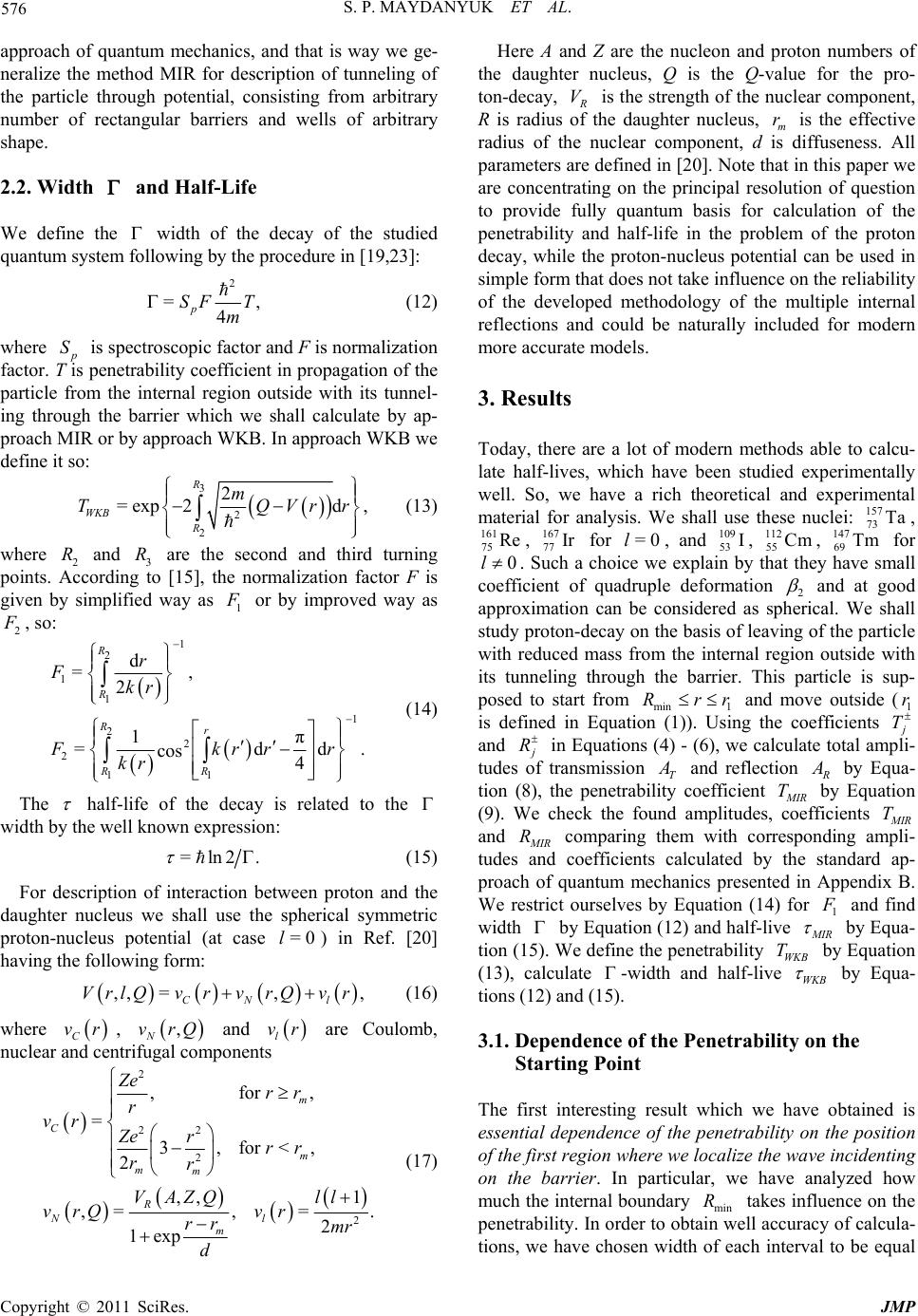 S. P. MAYDANYUK ET AL. 576 e define the width of the decay of the studied mrocedure in [19,23]: approach of quantum mechanics, and that is way we ge- neralize the method MIR for description of tunneling of the particle through potential, consisting from arbitrary number of rectangular barriers and wells of arbitrary shape. 2.2. Width and Half-Life W quantum syste following by the p 2 =, 4 p SF T m (12) where S Tis spectroscopic factor and F is normalization factor. is penetrability coefficien particle from the internal region outside with its tunnel- ug t in propagation of the ing throh the barrier which we shall calculate by ap- proach MIR or by approach WKB. In approach WKB we define it so: 3 2 2 =exp 2d R WKB m TQVrr , (13) 2 R where and are the second and third turning pointrdin], the normalization f given bymplifd way as 2 R s. Acco si 3 R g to [15 ie actor F is 1 or by improved way as 2 , so: 1 2 1 d =, Rr F 1 1 2 2 2 11 2 1π =dd. cos 4 R Rr RR kr Fk rrr kr (14) The half-life of the decay is related to the width by the well known expression: =ln2. (1 For description of interaction betwe 5) en proton and the daughter nucleus we shall use th proton-nucleus potential (at case ha nd are Coulomb, nuclear ponent e spherical symmetric =0l) in Ref. [20] ving the following form: ,, =,, CN l VrlQv rvrQvr (16) where C vr, , N vrQ a l vr s and centrifugal com 2 22 for , = C r vr Ze r 2 2 , 3, for <, 2 ,, 1 ,=, =. 2 1exp m m mm R Nl m Ze rr rr rr VAZQ ll vrQ vr rr mr d (17) Here A and Z are the nucleon and proton numbers of the daughter nucleus, Q is the Q-value for the pro- ton-decay, V of t he is the strength of the nuclear component, R is radius he daughter nucleus,is the effective radius of t nuclear component, dis diffusen parameters are defined in [20]. Note that in this paper we are concentrating on the principal resolution of question to provide fully quantum basis for calculation of the penetrability and half-life in the problem of the proton de clu m r ess. All cay, while the proton-nucleus potential can be used in simple form that does not take influence on the reliability of the developed methodology of the multiple internal reflections and could be naturally inded for modern more accurate models. 3. Results Today, there are a lot of modern methods able to calcu- late half-lives, which have been studied experimentally well. So, we have a rich theoretical and experimental material for analysis. We shall use these nuclei: 157 73 Ta , 161 75 Re , 167 77 Ir for =0l, and 109 112147r 053 I, 55Cm , 69Tm fo l . Such a choice we explain by that they qu have small coefficient ofadruple deformation 2 spheri an cal. d at good We shall a st pproximation cansidn be coered as udy proton-decay on the basis of leaving of the particle with reduced mass from the internal region outside with its tunneling through the barrier. This particle is sup- posed to start from min 1 Rrr and move outside ( 1 r is defined in Equation (1)). Using the coefficients T and R in Equations (4) - (6), we calculate total ampli- tudes of transmission T and reflection by Equa- tion (8), the penetrability coefficient IR T by Equation (9). We check the found amplitudes, coefficients IR T and IR R comparing them with corresponding ampli- tudes and coefficients calculated by the standard ap- proach of quantum mechanics presented in Appendix B. We restrict ourselves by Equation (14) for 1 and fin width d by Equation (12) and half-live IR by Equa- tion (15). We define the penetrability WKB T by Equation (13), calculate -width and half-live WKB by Equa- tions (12) and (15). 3.1. Dependence of the Penetrability on the Starting Point The first interesting result which we have btained is essential dependence of the penetrability o the position of the first region where we localize the wave in cidenting on the barrier. In particular, we have lyzed how much the internal bo o n ana undary takes influence on the la- equal min R penetrability. In order to obtain well accuracy of calcu tions, we have chosen width of each interval to be Copyright © 2011 SciRes. JMP  S. P. MAYDANYUK ET AL. 577 0.01he left boundary of the first terval as a starting point fm. We consider tmin R in tart gins to move outside and is incident on the internal part of the barrier in the first stage of the proton decay. In Figure 1 one can see that half-live of the proton decay of the 157 73 Ta emitter is changed essentially at displacement of R, from proton be- here tart R. So, we establish essetial dependence of the penetrability on the starting point n tart R, where the pro- ton starts to move outside by approach MIR. At = 7.2127 start R fm this dependence allo to achieve very close coincidence between the half-live calculated by the approach MIR and experimental data. 3.2. Dependence of the Penetrability on the rnal Region The region of the barrier located ben turning points 2 R and 3 R is main part of the potential used in calcu- enetrability in the semiclassical approach (up to the second correction), while the internal and ex- ternal parts of this potential do not take influ ws us e x max >RR e sam Exte n of th us an s g width o twe nce e ( be th latio e p e cre f in ence on it. alyze whether convists in calcula- in- da ). Keep- each interval (st, we shall L t a t erge ry max R ep) to tions of the penetrability in the approach MIR if to e the external boun3 ein increase max R (through increasing number of intervals he external region), starting from the external turning point 3 R, and calculate the corresponding penetrability IR T. In Figure 2 [left panel] one can see how the pene- trability is changed for 157 73 Ta with increasing max R. Dependence of the half-life IR on max R is shown in Figure 2 [right panel]. One can see that the method MIR gives convergent values for the etra half-life at increasing of max R. From such figures we find that inclusione external region into calculations changes the half-life up to 1.5 times (min =0.20 penbility and of th sec is the mi- nimal lf-life calculated at 3max 250RR fm, and as 0.30 ha = sec is the half-life calculated at max =250R fm, amin error =/1.5 s percents). So, error determination of the penetray in semiclassical approach (if to take the external region into account) is expected to be the same as a minimum on such a ba si s. 3.3. Results of Calculations of Half-Lives in Our and Semiclassical App e demonstrated above, the fully qu culatity of the barrier for the proton decay give us its essential dependence on the starting point. In order to give power of predictions of half-lives calculated by the approach MIR, we need to find recip or 50 bilit roa rtainty in calc in the u ches As we hav ions o to re antum cal- e penetrabil e e such uncelations of the f th bsolva le half-lives. So, we shall introduce the following hypothesis: Figure 1. Proton-decay for the nucleus: dependence of the half-life 157 73 Ta MIR on the starting point start (at fm ere calc = 7.2127 start Rwhulated MIR exp at th erimentalmax=R250 fm coincides wi exp data for this nucleus). Figure 2. Proton-decay for the nucleus: in the left panel the dependence on penetron the exter- nal boundary 157 73 Ta ability MIR max is presente right panel the dependence half-live d, in the of the MIR on max is presented (we use fm whe = 7. start R2127 re calculated MIR p at fm cowith experimental data max = 250R incides ex for this nucleus). In all calculations factor F is the same. Copyright © 2011 SciRes. JMP 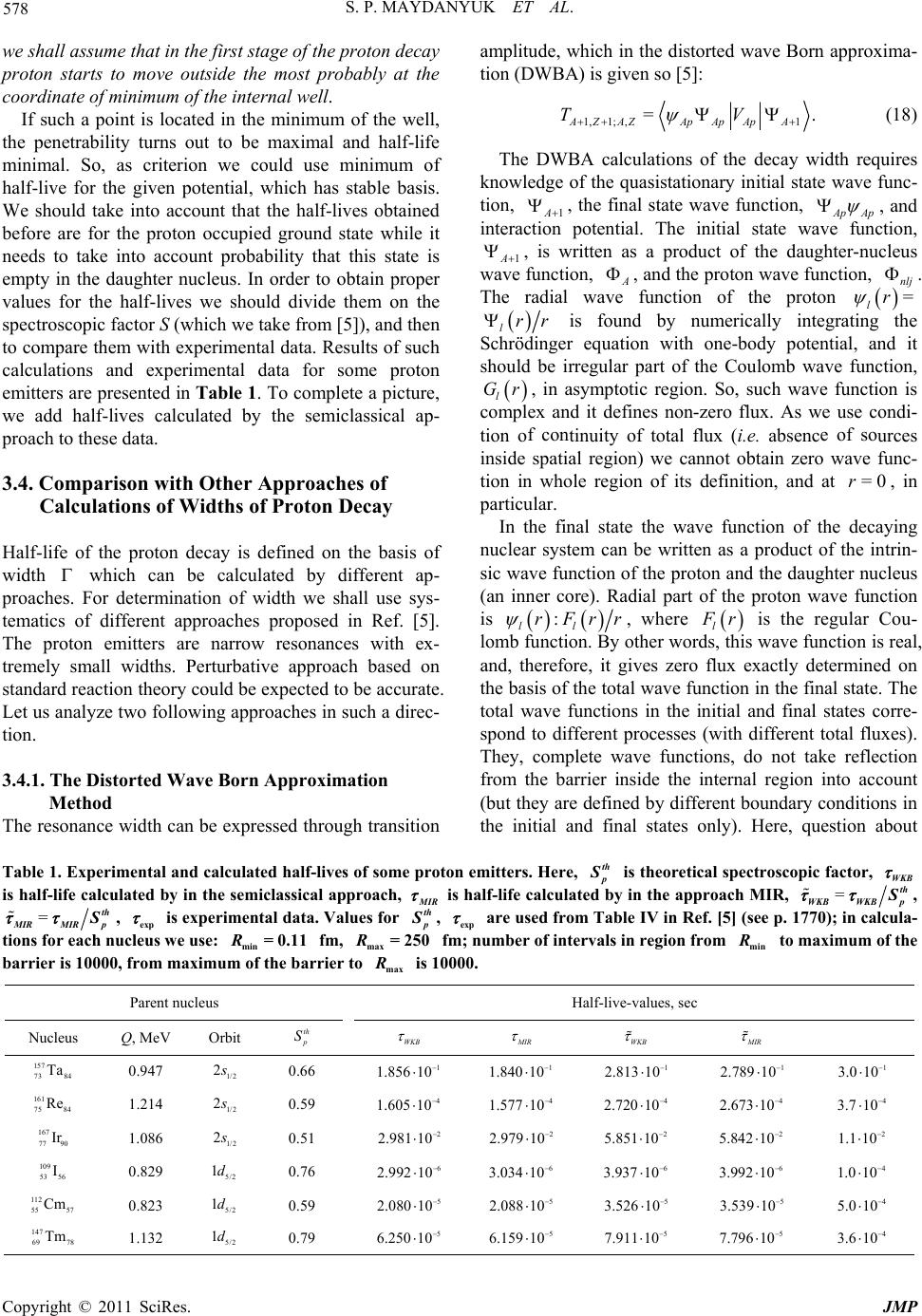 S. P. MAYDANYUK ET AL. Copyright © 2011 SciRes. JMP 578 we shall assume that in the first stage of the proton decay proton starts to move outside the most probably at the coordinate of mini mum of the internal wel l. If such a point is located in the minimum of the well, the penetrability turns out to be maximal and half-life minimal. So, as criterion we could use minimum of half-live for the given potential, which has stable basis. We should take into account that the half-lives obtained before are for the proton occupied ground state while it needs to take into account probability that this state is empty in the daughter nucleus. In order to obtain proper values for the half-lives we should divide them on the spectroscopic factor S (which we take from [5]), and the to compare them with experimental data. Results of such a omp ves oton Decay fferent ap- pr ma- tion ( given so [5]: amplitude, which in the distorted wave Born approxi DWBA) is 1,1;,1 =. AZA ZApApApA TV (18) The DWBA calculations of the decay width requires knowledge of the quasistationary initial state wave func- tion, , the final state wave function, Ap Ap e func 1A , and inpotential. The initial state wavtion, teraction 1A , is ncti written as a product of the daleus on, ughter-nuc wave fuA , and the proton wave function, nlj . The radial wave function of the proton =r l l Schröd should rr ing be i is d by numerically in er eqtion with one-body po rrepart of the Coulomb w foun ua gular tegrating tential, and it ave funct the ion, l Gr compl tion o inside s tion in , in ex an f con pat wh n calculations and experimental dat for some proton emitters are presented in Table 1. To clete a picture, we add half-licalculated by the semiclassical ap- proach to these data. 3.4. Comparison with Other Approaches of Calculations of Widths of Pr asymtic region. So, such wav d itnes non-zero flux. As tinuf total flux (i.e. absenc ial r) we cannot obtain zer ole of its definition, and particular. In the final state the wave function of the decaying nuclear system can be written as a product of the intrin- sic wave function of the proton and the daughter nucleus (an inner core). Radial part of the proton wave function is pto defi ity o egion region e functio we use co e of so o wave fu at =0r n is ndi- urces nc- , in Half-life of the proton decay is defined on the basis of width which can be calculated by di oaches. For determination of width we shall use sys- tematics of different approaches proposed in Ref. [5]. The proton emitters are narrow resonances with ex- tremely small widths. Perturbative approach based on standard reaction theory could be expected to be accurate. Let us analyze two following approaches in such a direc- tion. 3.4.1. The Distorted Wave Born Approximation Method The resonance width can be expressed through transition : ll rFrr , where l r rds, this is the regular Cou- lomb function. By other wo wave function is real, and, therefore, it gives zero flux exactly determined on the basis of the total wave function in the final state. The total wave functions in the initial and final states corre- spond to different processes (with different total fluxes). They, complete wave functions, do not take reflection from the barrier inside the internal region into account (but they are defined by different boundary conditions in the initial and final states only). Here, question about n emitters. Here, Table 1. Experimental and calculated half-lives of some prototh is theoretical spectroscopic factor, WKB is half-life calculated by in the semiclassical approach, MIR is half-life calculate by in the approach MIR, d= th pWKB WKB , = th IRMIRp , exp th , exp is experimental data. Values for are used from Table IV in Ref. [5] (see p. 1770); in ca fm; number of intervals in region from lcula- tions for each nucleus we use: min fm, max =0.11R=R250 min to maximum of the barrier is 10000, from maximum of the barrier to max is 10000. Parent nucleus Half-live-values, sec Nucleus Q, MeV Orbit th p S WKB IR WKB IR 157 73 84 Ta 0.947 1/2 2 0.66 1 1.856 10 1 1.840 10 1 2.81310 1 2.789 10 1 3.0 10 161 75 84 Re 1.214 1/2 2 0.59 4 1.605 10 4 1.577 10 4 2.720 10 4 2.673 10 4 3.7 10 167 77 90 Ir 1.086 1/2 2 0.51 2 2.981 10 2 2.979 10 2 5.851 10 2 5.842 10 2 1.1 10 109 53 56 I 0.829 5/2 1d 0.76 6 2.992 10 6 3.034 10 6 3.937 10 6 3.992 10 4 1.0 10 112 55 5 57 Cm 0.823 0.59 5/2 1d 2.080 10 5 2.088 10 5 3.526 10 5 3.539 10 4 5.0 10 147 69 78 Tm 1.132 0.79 5/2 1d 5 6.250 10 5 6.159 10 5 7.911 10 5 7.796 10 4 3.6 10 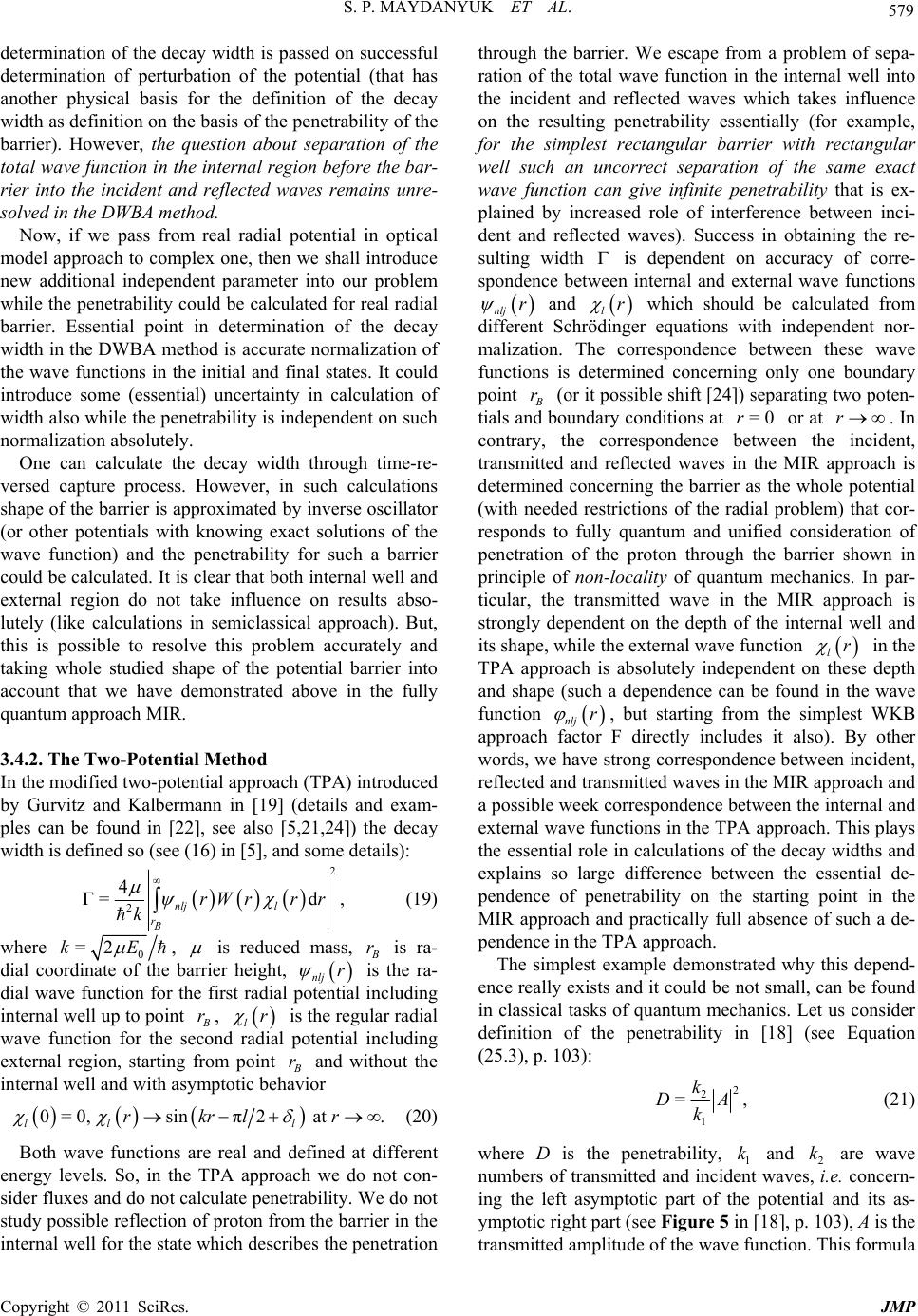 S. P. MAYDANYUK ET AL. 579 of the potential (that has another physical basis for the definition of the width as definition on the basis of the penet ba blem barrier. E introd One can calculate the decay width through time-re- ato (or other pote th trability f a barrie wel external region influence on results abso- lutely (like calcmiclassical aph). But, thisiblelveproblemccurately and taking whole stuape of the potial barrier into account that we demonrateden the fully quantum approaR. 3.4.2. Thwo-Pal Method In the mified ttential aproaPA) introduced by Gurvi and ann i19]ailxam- ples can be found in [22], see also [5,21,24]) the decay idth is definede (16) in, ametails): determination of the decay width is passed on successful determination of perturbation decay rability of the rrier). However, the question about separation of the total wave function in the internal region before the bar- rier into the incident and reflected waves remains unre- solved in the DWBA method. Now, if we pass from real radial potential in optical model approach to complex one, then we shall introduce new additional independent parameter into our pro while the penetrability could be calculated for real radial ssential point in determination of the decay width in the DWBA method is accurate normalization of the wave functions in the initial and final states. It could uce some (essential) uncertainty in calculation of width also while the penetrability is independent on such normalization absolutely. versed capture process. However, in such calculations shape of the barrier is approximated by inverse oscillr ntials with knowing exact solutions ofe wave function) and the peneor suchr could be calculated. It is clear that both internal l and do not take ulations in seproac s is pos to reso this a died sh have ten abovst i ch MI e Totenti odwo-popch (T tzKalbermn [ (dets and e w so (se [5]nd soe d 2 2 4 =d, nlj l rB rW rrr k (19) where 0 =2kE , is reduced mass, r is ra- dial coordinate of the barrier height, nlj r is the ra- dial wave function for the first radial potential including internal well up to point r, lr is the regular radial wave function for the second radial potential including ex ternal region, starting from point r and without the internal well and with asymptotic behavior 0=0,sinπ2 at . ll l rkrl r (20) Both wave functions are real and defined at different energy levels. So, in the TPA approach we do not con- sider fluxes and do not calculate penetrability. We do not study possible reflection of proton from the barrier in the internal well for the state which describes the penetration through the barrier. We escape from a problem of sepa- ration of the total wave function in the internal into the inciden well t and reflected waves which takes influence on ned by increas inter the resulting penetrability essentially (for example, for the simplest rectangular barrier with rectangular well such an uncorrect separation of the same exact wave function can give infinite penetrability that is ex- plaied role ofference between inci- dent and reflected waves). Success in obtaining the re- sulting width is dependent on accuracy of corre- spondence between internal and external wave functions nlj r and lr which should be calculated from different Schrödinger equations with independent nor- malization. The correspondence between these wave functions is determined concerning only one boundary point r (or it possible shift [24]) separating two poten- tials and boundary conditions at =0r or at r. In cont transm rincipl ticular, th strongly its shap rary, the e o corresponde oca e ex nce betnt, itted and reflected wavee MIR approach is ble or f lity of quantechanics. r- e trane ine MIR is depth intend rnal wavtion w s in th h th um m th of the e fun een the incide m) that c In pa approach rnal well a determined concerning the barrier as the whole potential (with needed restrictions of the radial pro- responds to fully quantum and unified consideration of penetration of the proton througe barrier shown in pnon-l ile th smitted wav pendent on the de e, whtec lr hese de n the wa n t d i inthe soluely indent oh spendence canve TPA app and shape function roac ( h b uc de is a h a t pende be f pt oun r, or F nlj but starting fros directly inclus it alsoher words, weave strong cpondence een incident, reflected ad transmitted waves in the MIR approach and a possible k correspondence betwee external wave functions in the TPA approach. This pl the essential role in calcs of the cay widths ce between the essential de- m th de e implest WKB ). By otapproach fact horresbetw n wee n the internal and ays ulationde and explains so large differen pendence of penetrability on the starting point in the MIR approach and practically full absence of such a de- pendence in the TPA approach. The simplest example demonstrated why this depend- ence really exists and it could be not small, can be found in classical tasks of quantum mechanics. Let us consider definition of the penetrability in [18] (see Equation (25.3), p. 103): 2 2 1 =, k DA k (21) where D is the penetrability, and are wave umbers of transmitted and inci waves concern- potential and its as- 1 k dent 2 k , i.e.n ing the left asymptotic part of the ymptotic right part (see Figure 5 in [18], p. 103), A is the transmitted amplitude of the wave function. This formula Copyright © 2011 SciRes. JMP 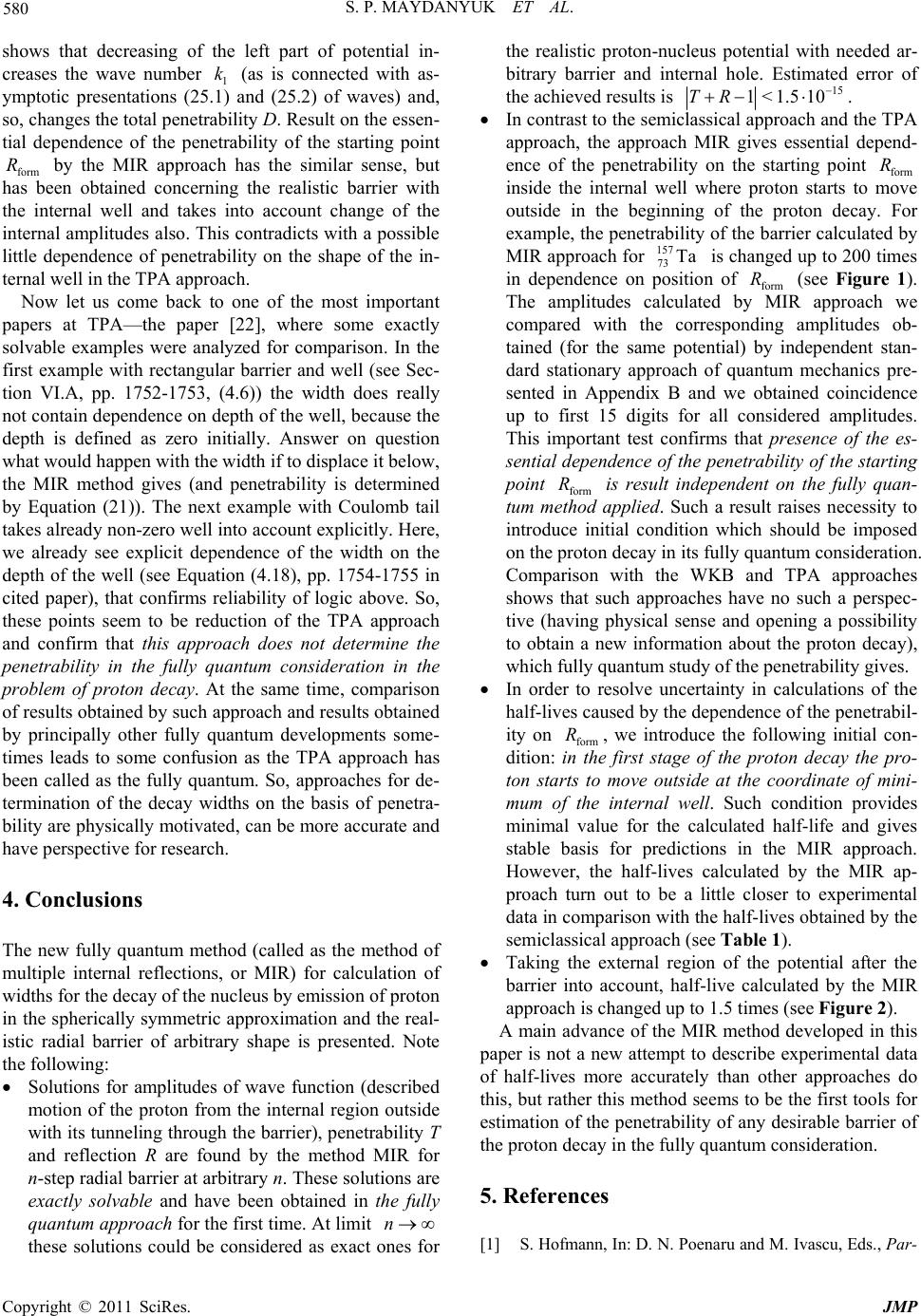 S. P. MAYDANYUK ET AL. 580 - ymptotic presentations (2 and (25.2) of waves) and, so, changes the total penelity D. Result o tial dependence of the penility of the starting point he MIR apoa ic b ntra e exact le examples were analyzed for comparison o n her on (de flectio shows that decreasing of the left part of potential in- creases the wave number 1 k (as is connected with as 5.1) trabi etrab n the essen- form R by tprch has the similar sense, but has been obtained concerning the realstiarrier with the internal well and takes into account change of the internal amplitudes also. This codicts with a possible little dependence of penetrability on the shape of the in- ternal well in the TPA approach. Now let us come back to one of the most important papers at TPA—the paper [22], where somly . In the solvab fir ri st example with rectangular barrier and well (see Sec- tion VI.A, pp. 1752-1753, (4.6)) the width does really not contain dependence on depth of the well, because the depth is defined as zero initially. Answer on question what would happen with the width if to displace it below, the MIR method gives (and penetrability is determined by Equation (21)). The next example with Coulomb tail takes already non-zero well into account explicitly. Here, we already see explicit dependence of the width on the depth of the well (see Equation (4.18), pp. 1754-1755 in cited paper), that confirms reliability of logic above. So, these points seem to be reduction of the TPA approach and confirm that this approach does not determine the penetrability in the fully quantum consideration in the problem of protn decay. At the same time, comparison of results obtained by such approach and results obtained by pcipally ot fully quantum developments some- times leads to some confusion as the TPA approach has been called as the fully quantum. So, approaches for de- termination of the decay widths on the basis of penetra- bility are physically motivated, can be more accurate and have perspective for research. 4. Conclusions The new fully quantum method (called as the method of multiple internal reflections, or MIR) for calculation of widths for the decay of the nucleus by emission of proton in the spherically symmetric approximation and the real- istic radial barrier of arbitrary shape is presented. Note the following: Solutions for amplitudes of wave functiscribed motion of the proton from the internal region outside with its tunneling through the barrier), penetrability T and ren R are found by the method MIR for n-step radial barrier at arbitrary n. These solutions are exactly solvable and have been obtained in the fully quantum approach for the first time. At limit n these solutions could be considered as exact ones for the realistic proton-nucleus potential with needed ar- bitrary barrier and internal hole. Estimated error of the achieved results is 15 1<1.510TR . In contrast to the semiclassical approach and the TPA approach, the approach MIR gives essential depend- ence of the penetrability on the starting point ce onn of (see Figur The amplitudes calculated by MIR approac compared with thesp tained (for the samential) bependen form inside the internal well where proton starts to move outside in the beginning of the proton decay. For example, the penetrability of the barrier calculated by MIR approach for 157 73 Ta is changed up to 200 times in dependen R e 1). h we t stan- positio corre e pot ch form R on y ind ding amplitudes ob- dard stationary approach of quantum mechanics pre- sented in Appendix B and we obtained coincidence up to first 15 digits for all considered amplitudes. This important test confirms that presence of the es- sential dependence of the p enetrability of the starting point form R is result independent on the fully quan- tum method applied. Su a result raises necessity to introduce initial condition which should be imposed on the proton decay in its fully quantum consideration. Comparison with the WKB and TPA approaches shows that such approaches have no such a perspec- tive (having physical sense and opening a possibility to obtain a new information about the proton decay), which fully quantum study of the penetrability gives. In order to resolve uncertainty in calculations of the half-lives caused by the dependence of the penetrabil- ity on form R, we introduce the following initial con- dition: in the first stage of the proton decay the pro- ton starts to move outside at the coordinate of mini- mum of the internal well. Such condition provides minimal value for the calculated half-life and gives stable basis for predictions in the MIR approach. However, the half-lives calculated by the MIR ap- proach turn out to be a little closer to experimental data in comparison with the half-lives obtained by the semiclassical approach (see Table 1). Taking the external region of the potential after the barrier into account, half-live calculated by the MIR approach is changed up to 1.5 times (see Figure 2). A main advance of the MIR method developed in this paper is not a new attempt to describe experimental data of half-lives more accurately than other approaches do this, but rather this method seems to be the first tools for estimation of the penetrability of any desirable barrier of the proton decay in the fully quantum consideration. 5. References [1] S. Hofmann, In: D. N. Poenaru and M. Ivascu, Eds., Par- Copyright © 2011 SciRes. JMP 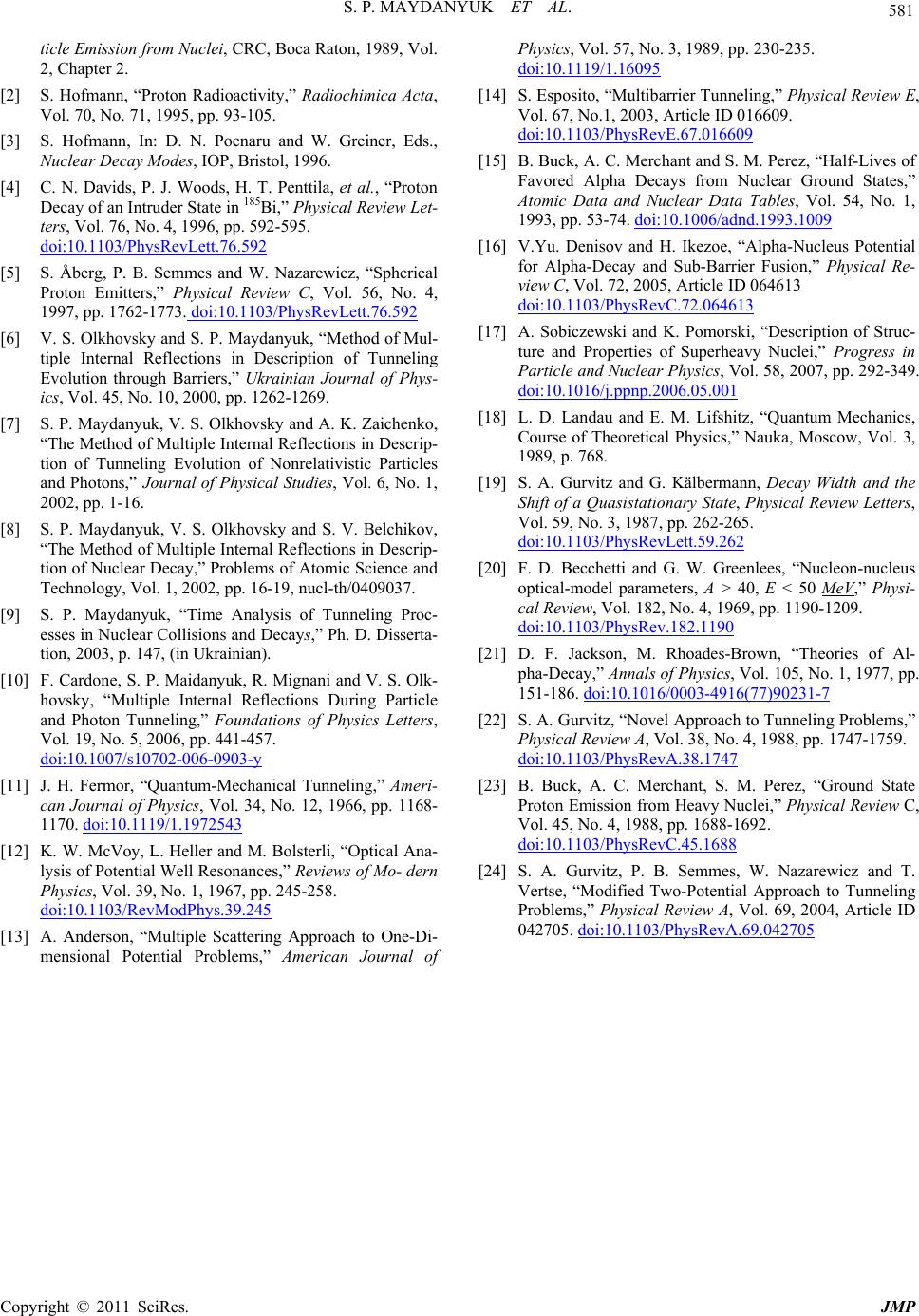 S. P. MAYDANYUK ET AL. Copyright © 2011 SciRes. JMP 581 ] S. Hofmann, “Proton Radioactivity,” Radiochimica Acta 1995, pp. 93-105. : D. N. Poenaru and W. Greiner, Eds. ticle Emission from Nuclei, CRC, Boca Raton, 1989, Vol. 2, Chapter 2. [2 , , Vol. 70, No. 71, ] S. Hofmann, In[3 Nuclear Decay Modes, IOP, Bristol, 1996. [4] C. N. Davids, P. J. Woods, H. T. Penttila, et al., “Proton Decay of an Intruder State in 185Bi,” Physical Review Let- ters, Vol. 76, No. 4, 1996, pp. 592-595. doi:10.1103/PhysRevLett.76.592 [5] S. Åberg, P. B. Semmes and W. Nazarewicz, “Spherical Proton Emitters,” Physical Review C, Vol. 56, No. 4, 1997, pp. 1762-1773. doi:10.1103/PhysRevLett.76.592 [6] V. S. Olkhovsky and S. P. Maydanyuk, “Method of Mul- tiple Internal Reflections in Description of Tunneling Evolution through Barriers,” Ukrainian Journal of Phys- ics, Vol. 45, No. 10, 2000, pp. 1262-1269. [7] S. P. Maydanyuk, V. S. Olkhovsky and A. K. Zaichenko, “The Method of Multiple Internal Reflections in Descrip- tion of Tunneling Evolution of Nonrelativistic Particles and Photons,” Journal of Physical Studies, Vol. 6, No. 1, 2002, pp. 1-16. [8] S. P. Maydanyuk, V. S. Olkhovsky and S. V. Belchikov, “The Method of Multipn Descrip-le Internal Reflections i tion of Nuclear Decay,” Problems of Atomic Science and Technology, Vol. 1, 2002, pp. 16-19, nucl-th/0409037. [9] S. P. Maydanyuk, “Time Analysis of Tunneling Proc- esses in Nuclear Collisions and Decays,” Ph. D. Disserta- tion, 2003, p. 147, (in Ukrainian). [10] F. Cardone, S. P. Maidanyuk, R. Mignani and V. S. Olk- hovsky, “Multiple Internal Reflections During Particle and Photon Tunneling,” Foundations of Physics Letters, Vol. 19, No. 5, 2006, pp. 441-457. doi:10.1007/s10702-006-0903-y [11] J. H. Fermor, “Quantum-Mechanical Tunneling,” Ameri- can Journal of Physics, Vol. 34, No. 12, 1966, pp. 1168- 1170. doi:10.1119/1.1972543 [12] K. W. McVoy, L. Heller and M. Bolsterli, “Optical Ana- lysis of Potential Well Resonances,” Reviews of Mo- dern Physics, Vol. 39, No. 1, 1967, pp. 245-258. doi:10.1103/RevModPhys.39.245 [13] A. Anderson, “Multiple Scattering Approach to One-Di- mensional Potential Problems,” American Journal of Physics, Vol. 57, No. 3, 1989, pp. 230-235. doi:10.1119/1.16095 [14] S. Esposito, “Multibarrier Tunneling,” Physical Review E, Vol. 67, No.1, 2003, Article ID 016609. doi:10.1103/PhysRevE.67.016609 [15] B. Buck, A. C. Merchant and S. M. Perez, “Half-Lives of Favored Alpha Decays from Nuclear Ground States,” Atomic Data and Nuclear Data Tables, Vol. 54, No. 1, 1993, pp. 53-74. doi:10.1006/adnd.1993.1009 [16] V.Yu. Denisov and H. Ikezoe, “Alpha-Nucleus Potential for Alpha-Decay and Sub-Barrier Fusion,” Physical Re- view C, Vol. 72, 2005, Article ID 064613 doi:10.1103/PhysRevC.72.064613 [17] A. Sobiczewski and K. Pomorski, “Description of Struc- ture and Properties of Superheavy Nuclei,” Progress in Particle and Nuclear Physics, Vol. 58, 2007, pp. 292-349. doi:10.1016/j.ppnp.2006.05.001 and E. M. Lifshitz, “Quantum Mechanics, oretical Physics,” Nauka, Moscow, Vol. 3, [18] L. D. Landau Course of The 1989, p. 768. [19] S. A. Gurvitz and G. Kälbermann, Decay Width and the Shift of a Quasistationary State, Physical Review Letters, Vol. 59, No. 3, 1987, pp. 262-265. doi:10.1103/PhysRevLett.59.262 [20] F. D. Becchetti and G. W. Greenlees, “Nucleon-nucleus optical-model parameters, A > 40, E < 50 MeV,” Physi- cal Review, Vol. 182, No. 4, 1969, pp. 1190-1209. doi:10.1103/PhysRev.182.1190 [21] D. F. Jackson, M. Rhoades-Brown, “Theories of Al- pha-Decay,” Annals of Physics, Vol. 105 151-186. , No. 1, 1977, pp. 7)90231-7doi:10.1016/0003-4916(7 [22] S. A. Gurvitz, “Novel Approach to Tunneling Problems,” Physical Review A, Vol. 38, No. 4, 1988, pp. 1747-1759. doi:10.1103/PhysRevA.38.1747 [23] B. Buck, A. C. Merchant, S. M. Perez, “Ground State Proton Emission from Heavy Nuclei,” Physical Review C, Vol. 45, No. 4, 1988, pp. 1688-1692. doi:10.1103/PhysRevC.45.1688 [24] S. A. Gurvitz, P. B. Semmes, W. Nazarewicz and T. Vertse, “Modified Two-Potential Approach to Tunneling Problems,” Physical Review A, Vol. 69, 2004, Article ID 042705. doi:10.1103/PhysRevA.69.042705 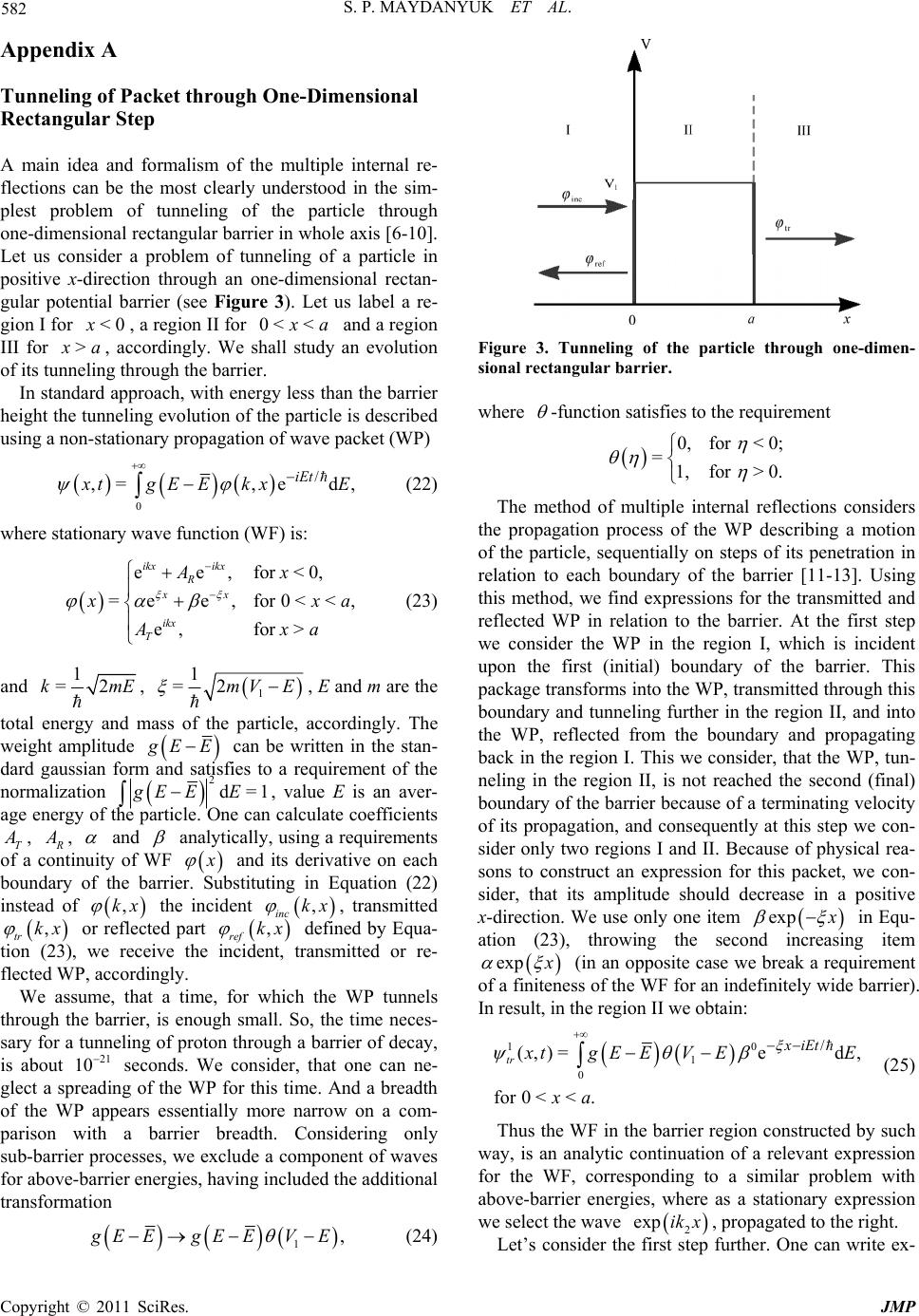 S. P. MAYDANYUK ET AL. 582 le through nsional rect Appendix A Tunneling of Packet through One-Dimensional Rectangular Step A main idea and formalism of the multiple internal re- flections can be the most clearly understood in the sim- plest problem of tunneling of the partic one-dimensional rectangular barrier in whole axis [6-10]. Let us consider a problem of tunneling of a particle in positive x-direction through an one-dimean- gular potential barrier (see Figure 3). Let us label a re- gion I for <0x, a region II for 0< < a and a region III for > a, accordingly. We shall study an evolution of its tunneling through the barrier. In standard approach, with energy less than the barrier height the tunneling evolution of the particle is described using a non-stationary propagation of wave packet (WP) 0 / ,=,ed, iEt tgEEkx E (22) where stationary wave function (WF) is: =ee,for 0<<, e,for > xx ikx T ee,for <0, ikx ikx R Ax xa Ax a (23) and 1 =2kmE , 1 1 =2mV E , E and m are the total energy and mass of the particle, accordingly. The weight amplitude EE an can be written in the stan- dard gaussian formd satisfies to a requirement of the normalization 2d=1gEEE he particle. On , value E is an aver- age energy of te can calculate coefficients T , , and WF analytically, using a requirements ity of of a continu rrier. Sub incid part the in and its derivative on each he bstituting in Equation (22) ent , transmitted d by Equa- itted or re- flected WP, accordingly. We assume, that a time, for which the WP tunnels through the barrier, is enough small. So, the time neces- sary for a tunneling of proton through a barrier of decay, is about seconds. We consider, that one can ne- glect a sg of the WP for this time. And a breadth of the WP appears essentially more narrow on a com- parison with a barrier breadth. Considering only sub-barrier processes, we exclude a component of waves for above-barrier energies, having included the additional transformation boun tr da instead of ,kx tion (23), ry of t or we a the ve ,kx reflected recei , inc kx ,kx define nt, transm ref cide 21 10 preadin 1, EEgEEV E Figure 3. Tunneling of the particle through one-dimen- sional rectangular barrier. where -function satisfies to the requirement 0,for <0 = ; 1, for >0. The method of multiple internal reflections considers the propagation process of the WP describing a motion of the particle, sequentially on steps of its penetration in relation to each boundary of the barrier [11-13]. Using this method, we find expressions for the transmitted and reflected WP in relation to the barrier. At the first step we consider the WP in the region I, which is incident upon the first (initial) boundary of the barrier. This package transforms into the WP, transmitted through this boundary and tunneling further in the region II, and into the WP, reflected from the boundary and propagating back in the region I. This we consider, that the WP, tun- neling in the region II, is not reached the second (final) boundary of the barrier because of a terminating velocity of its propagation, and consequently at this step we con- sider only two regions I and II. Because of physical rea- sons to construct an expression for this packet, we con- sider, that its amplitude should decrease in a positive x-direction. We use only one item exp nd incr in Equ- ation (23), throwing the secoeasing item exp of a finite (in an opposite case werequirement ness of the WF for an inbarrier). In result, in the region II we obtain: break a definitely wide 10 1 0 / (,)=ed , for 0<<. tr xiEt tgEEVE E a (25) Thus the WF in the barrier region constructed by such way, is an analytic continuation of a relevant expression for the WF, corresponding to a similar problem with above-barrier energies, where as a stationary expression we select the wave 2 exp ikx, the first step propagated to the right. Let’s consider further. One can write ex- (24) Copyright © 2011 SciRes. JMP 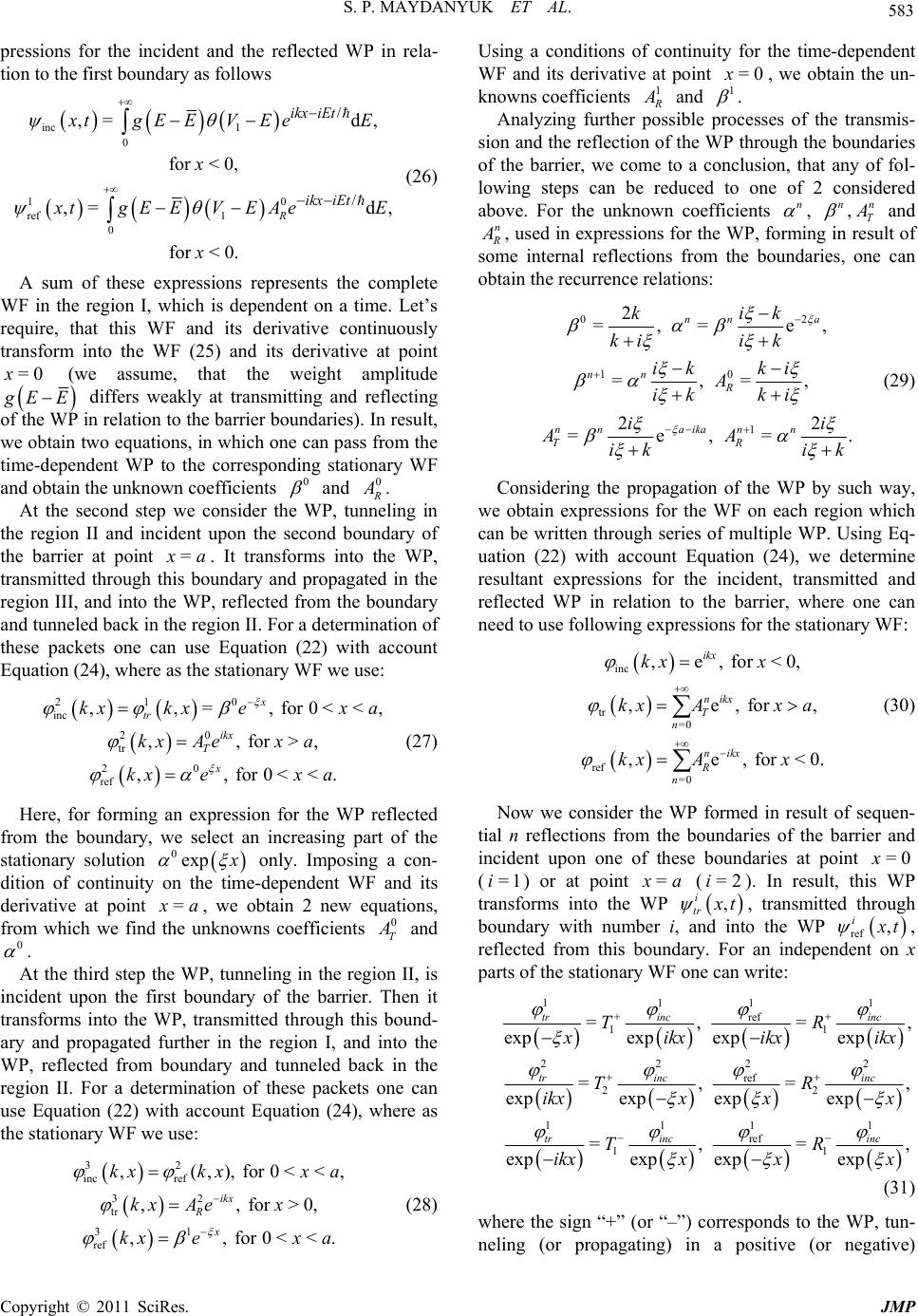 S. P. MAYDANYUK ET AL. 583 ncident and the reflected WP in rela- on to the first boundary as follows pressions for the i ti 1 0 d, inc / ,= ikx iEt 10 ref 1 0 / for <0, ,= d, for <0. Rikx iEt tgEEVEe E x tgEEVEAe E x (26) A sum of these expressions represents the complete WF in the region I, which is dependent on a time. Let’s require, this WF and its d continuously transforo the WF (25) and its derivative at point =0x (we assume, that the at therivative m int weight amplitude EE differs weakly at transmitting and reflecting of the WP in relation to the barrier boundaries). In result, we obtain two equations, in which one can pass from the time and ob -dependent WP to the corresponding stationary WF tain the unknown coefficients 0 and 0 . At the second step we consider thWP, tling in d boundary of the barrier at point e unne the region II and incident upon the secon = a. It transforms into the WP, transmitted through this boundary and propagated in the region III, and into the WP, reflected from the and tunneled back in the region II. For a determination of these packets one can use Equation (22) with account whee as the stationary WF we use: from the une boundary Equation (24), r inc 20 tr 20 ref ,,=, for 0 <<, , for >, ,r 0 <<. tr ikx x kxkxex a kxxa kxx a (27) Here, for forming an expression for the WP reflected bodary, wselect an increasing part of the stationary solution 0exp 210 , , fo x T Ae e y. Imposing a con- dition of continuity on the time-dependent WF and its derivative at poin = onl t a, we obtain 2uations, from wind the unknowns co0 T new eq hich we fefficients and 0 . At the third step the WP, tunneling in the reg II, is in cted (28) Using a conditions of continuity for the time-dependent WF and its derivative at point , we obtain the un- knowns coefficients ion cident upon the first boundary of the barrier. Then it transforms into the WP, transmitted through this bound- ary and propagated further in the region I, and into the WP, refle from boundary and tunneled back in the region II. For a determination of these packets one can use Equation (22) with account Equation (24), where as the stationary WF we use: 32 inc ref 3 tr ,(,), for 0<<,kxkxxa kx 2 31 ref ,, for > 0, ,, for 0 <<. ikx R x Aex kxex a =0x 1 and 1 . rocesAnalyzing further pblses of the transmis- sion and the reflection of the WP through the boundaries of the barrier, we come to a conclusion, that any of fol- lowing steps can be reduced to one of 2 considered above. For the unknown coefficients ossie p n , n ,n T and n , used in expressions for the WP, ft of e internal reflections from n obtain the recurrence relations: orming in r the boundaries, one ca esul som 02 1 =, nn ki i k ik 0 2 =,= e, =, =e,=. nna R TR kik ki A ik ki AA ik ik 1 22 nn aikan n ii (29) Considering the propagation of the WP by such way, we obtain expressions for the WF on each region which can be written through series of multiple WP. Using Eq- uation (22) with account Equation (24), we determine resultant expressions for the incident, transmitted and reflected WP in relation to the barrier, where one can need to use following expressions for the stationary WF: inc tr =0 ref =0 ,e, for < 0, ,e, for , ,e, for < 0. ikx nikx T n nikx R n kx x kxAx a kx Ax (30) Now we consider the WP formed in result of sequen- tial n reflections from the boundaries of the barrier and incident upon one of these boundaries at point =0x (=1i) or at point = a (=2i). In result, this WP transforms into the WP , i tr t , transmitted through boundary with number i, and into the WP ref , i t , reflected rom this boundary. For an independent on x parts of the stationary WF one can write: f 111 ref =, tr inc TR 1 11 222 ref 22 =, expexp expexp =,=, expexp expexp inc tr inc2 inc 11 1 1 ref 11 =, =, expexp expexp tr inc inc ikx ikxikx TR ikxx xx (or “–”) c - ne TR ikx x xx (31) where the sign “+” orresponds to the WP, tun ling (or propagating) in a positive (or negative) Copyright © 2011 SciRes. JMP  S. P. MAYDANYUK ET AL. 584 ecisely describe an arb ichs formed in result of n-multiple reflectio to kn a “path” of its propagation along the barring turrence relations Equation (29), the coets can be obtained. x-direction and incident upon the boundary with number i. Using i T and i R, one can pr itrary WP wh ns, if er. Usi fficien ha ow he rec and i Ti R 1 0 12 1 1 0 12 1 =, = ,=. Rnn RARR Using the recurrence relations, one can find series of coefficients n =,= ,=, nn TR nn nn AA TT T (32) , n , n T and n . However, these can be calculated easier, using coefficients i T series Analyzing all possible “paths” of the WP propagations along the barrier, we receive: and i R. 2 0 11 21 21 =0 =1 2 0 21 =0 =1 0 21 =0 =1 1= , 2e 1= , 2 1= n n R nn sub a n n nn sub n n ni s kD ARTRTRRF ki k RR F ki k RR F 21 21 =0 =1 4e 1=, aika n n T nn sub ik ATT RRF , ub (33) where 22 2 222 1 02 2 =. 2, 1, sub a kDikD De mV kk (34) All series n , n , n T and n , obtained using the method of multiple internal reflections, coin- cide with the corresponding coefficients , , T and of the Equation (23), calculated by a stnary atio methods [18]. Using the following substitution 2,ik (35) where 21 1 =2 kmEV is a wave number for a case of above-barrier energies, expression for the coefficients n , n , n T and n for each step, expressions for the WF for each step, the total Equations (33) and (34) the coesponding expressions for a prob- orticle pgation above this barrier. At the a of tWP and the time-dep toge a sign of argument at tran lem tran one sform f th sform can into e pa tion need rr ropa he chan endent WF -function. Besid 22 =0 =0 1. nn TR nn AA (36) = We f to use only condi- tion of continuity of the wave function and its derivative at each boundary, but on the whole region of the studied potential. At first, we find functions Appendix B Direct Method shall add shortly solution for amplitudes of the wave function obtained by standard technique of quantum mechanics which could be obtained i 2 and 2 (from the first boundary): 121 21 2 21 1 22 21 12 2 =e,=e ikkx ik x kk k fg kk kk . (37) Then, using the following recurrent relations: 1 2 11 2 12 11 ee, e jj j jj ik x jj jjj ik x jik x jj jjj kk fkk fkk fkk (38) we calculate next functions 3 , 4 , 5 n , and by such a formula: 1 2ejjj ikk x j 12 11 ejj jj ik x jjjj gg kk fkk (39) the functions k 3 , 4 , 5 n n and n . From we find amplitudes n , n and amplitude oran sion f tsmis- T : =0,= =. n nT n A n (40) Now using the recurrent relations: 1111 1 11 1 1 1 eee ee jjj j jj jj ik xikxikx jj j jik xikx j g f 1 jj (41) and such a formula: =, jj j g (42) we consistently calculate the amplitudes , 1n 1n , 2n , 2n 2 , 2 . At finishing, we find ampli- tude of reflection : 121121 11 2 22 =eee . ik k xik k xik x R A (43) As test we use condition: 22 1 =1. nTR kAA k (44) Studying the problem of proton decay, we used such a techniques for check the amplitudes obtained previously ellowing property is fulfilled: s the fo Copyright © 2011 SciRes. JMP 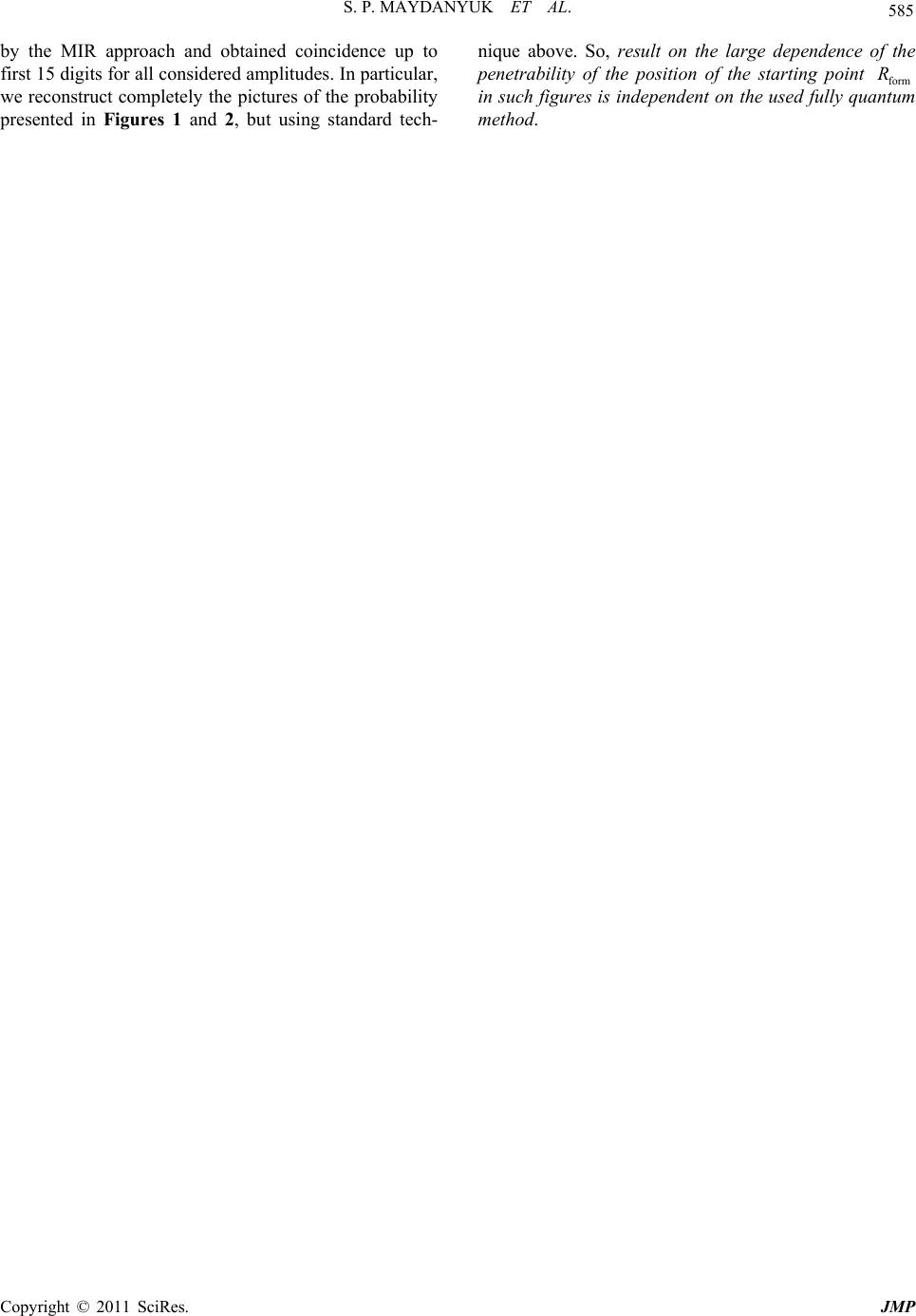 S. P. MAYDANYUK ET AL. Copyright © 2011 SciRes. JMP 585 nique above. So, result on the large dependence of the penetrability of the position of the star in such figures is independent on the used fully quantum ethod. by the MIR approach and obtained coincidence up to first 15 digits for all considered amplitudes. In particular, we reconstruct completely the pictures of the probability presented in Figures 1 and 2, but using standard tech- ting point form R m
|